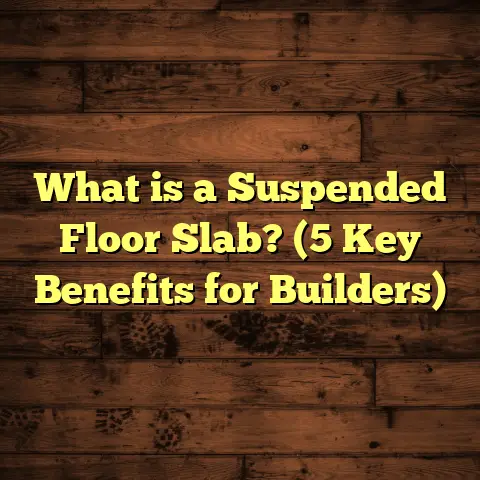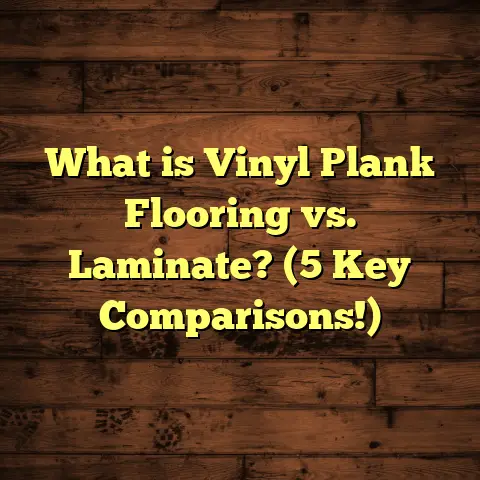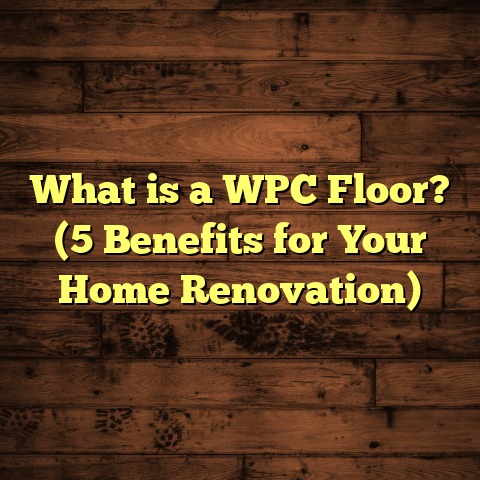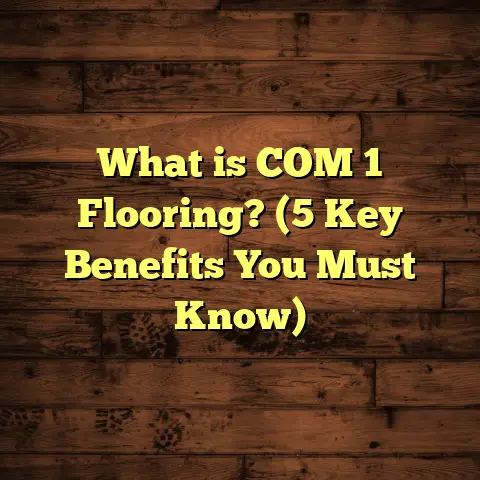What is Paperbag Flooring? (7 Benefits for Eco-Friendly Homes)
Innovation in flooring materials keeps surprising me. Just when I think I’ve seen all the usual hardwoods, laminates, vinyls, and tiles, something new pops up that not only looks great but also helps take care of our planet. Paperbag flooring is one of those discoveries that made me stop and rethink what sustainable flooring can look like. It’s eco-friendly, stylish, surprisingly durable, and affordable — and it’s been gaining traction for good reasons. If you haven’t heard of it yet or are on the lookout for a new flooring option that’s both green and practical, let me share everything I know about paperbag flooring. We’ll talk about what it is, how it compares to other floors I’ve worked with, and why it might be just the thing your eco-friendly home needs.
What Is Paperbag Flooring?
What exactly is paperbag flooring? The name itself sounds a bit quirky at first, right? But the idea behind it is pretty straightforward and clever. Paperbag flooring is a type of floor covering made mainly from recycled paper fibers that are compressed tightly and treated to create solid, durable panels or tiles. These panels are then coated with natural or water-based sealants to make them moisture-resistant and strong enough for everyday use.
Think of it like this: instead of tossing paper waste into landfill piles, these fibers are given a second life as a flooring material that’s both functional and beautiful. The manufacturing process uses eco-conscious methods with minimal chemicals and energy, which sets it apart from more traditional options like hardwood or vinyl.
When I first came across paperbag flooring, I was skeptical about how durable something made from paper could really be. But after testing samples and even installing it in a few homes, I was pleasantly surprised by its strength and resilience. The floor feels warm and inviting underfoot — much cozier than cold tile or laminate — and it has a unique texture that adds character to any space.
The Story Behind Paperbag Flooring
One of the things I love about this flooring type is its story. It originated from efforts to reduce paper waste and find innovative ways to recycle materials we often take for granted. Paper accounts for nearly 23% of municipal solid waste in the United States alone, according to the Environmental Protection Agency (EPA). That’s a massive amount of material ending up in landfills every year.
Seeing this problem, some manufacturers started experimenting with compressing recycled paper into dense boards, adding eco-friendly binders and sealants to create a product that could rival hardwood or laminate flooring in quality but leave a smaller environmental footprint.
Beyond the environmental benefits, paperbag flooring also offers an aesthetic appeal that’s quite different from typical wood grains or vinyl patterns. Its surface shows subtle variations and textures from the compressed fibers — giving each plank or tile a distinct look that complements both rustic and modern interiors.
Comparing Paperbag Flooring to Other Popular Flooring Materials
I’ve installed many types of floors over the years: hardwoods, laminates, vinyl sheets and planks, bamboo, cork—the list goes on. Each has pros and cons depending on the job, budget, and client preferences. Here’s how paperbag flooring compares based on my hands-on experience:
| Flooring Type | Durability | Eco-Friendliness | Maintenance | Cost Range (per sq. ft) | Aesthetic Variety |
|---|---|---|---|---|---|
| Hardwood | Very High | Moderate | Moderate | $6 – $12 | High |
| Laminate | Moderate | Low | Low | $2 – $5 | High |
| Vinyl | Moderate | Low | Very Low | $2 – $7 | High |
| Bamboo | High | High | Moderate | $3 – $8 | Moderate |
| Cork | Moderate | High | Moderate | $3 – $9 | Moderate |
| Paperbag | Moderate | Very High | Low | $3 – $6 | Moderate |
This table shows some clear strengths of paperbag flooring. While its durability isn’t quite on par with hardwood or some bamboo options, it holds its own in typical home settings. Its eco-friendliness shines because of the recycled content and low-impact manufacturing.
My First Installation Experience With Paperbag Flooring
I remember my first project involving paperbag flooring vividly. It was for a young couple passionate about sustainability who wanted their living space to reflect their values. They had looked at bamboo and cork but found those options either too pricey or not quite fitting their style.
After suggesting paperbag flooring, they were intrigued but cautious. So was I! We ordered samples and I brought them over during a consultation. The texture caught their eye immediately — that natural fiber look was different but inviting.
Installation day was surprisingly smooth. The panels clicked together easily thanks to a click-lock system similar to laminate floors. The couple were thrilled with how warm the floor felt underfoot compared to cold tiles they’d previously considered.
Months later, I checked in with them. They reported minimal maintenance—just regular sweeping and occasional damp mopping—and no noticeable wear despite kids running around. Plus, they loved knowing their floor helped keep tons of paper out of landfills.
7 Benefits of Paperbag Flooring for Eco-Friendly Homes
Why do I recommend paperbag flooring so often now? Here are seven key reasons based on experience and research.
1. Made From Recycled Materials
This is probably the biggest selling point for me as a contractor committed to green building practices. Paperbag flooring primarily uses recycled paper fibers — post-consumer waste that otherwise would contribute to landfills.
According to EPA data, Americans generated about 67 million tons of paper waste in recent years. Recycling this material into flooring helps close the loop on waste management by turning trash into treasure.
2. Low Environmental Impact During Production
Manufacturing paperbag panels consumes less water and energy than traditional hardwood processing or synthetic vinyl manufacturing. Plus, no harsh chemicals go into making these floors.
The sealants used are often water-based or natural oils that emit very low volatile organic compounds (VOCs), helping maintain healthier indoor air quality.
3. Cost-Effective Without Compromising Style
Paperbag flooring typically costs between $3 and $6 per square foot installed — making it accessible for many budgets while providing a premium feel.
When I compare this with hardwood floors costing upwards of $10 per square foot installed, it’s clear that paperbag flooring offers savings without sacrificing design appeal.
4. Quick and Easy Installation Process
If you’re handy or planning a DIY project, this floor is a great pick. The panels usually feature click-lock edges allowing fast installation without glue or nails.
In my projects, this meant less downtime for clients and fewer issues during setup compared to glue-down vinyl or nail-down hardwood.
5. Comfortable Underfoot and Thermally Insulating
Unlike tile or stone floors that can feel cold—especially in winter—paperbag flooring’s compressed fiber composition provides natural insulation. It’s soft enough to be comfortable but firm enough to handle foot traffic.
One family I worked with mentioned how much warmer their living room felt after switching to paperbag floors compared to their old ceramic tiles.
6. Resistant to Everyday Moisture Spills
While not suitable for bathrooms or places with constant moisture exposure, sealed paperbag floors can handle kitchen spills or minor accidents without warping or damage.
I’ve advised clients to wipe spills promptly but have rarely seen issues where moisture caused problems in living rooms or bedrooms.
7. Unique Textured Aesthetics That Stand Out
The texture created by compressed recycled fibers gives each plank subtle unique patterns — a contrast to uniform laminate or vinyl designs.
This natural variation adds warmth and personality to interiors ranging from rustic cabins to modern apartments.
Deep Dive Into Data: How Paperbag Flooring Measures Up Environmentally
Several studies have looked at recycled fiber-based floorings like paperbag products from multiple perspectives:
- Lifecycle Assessment (LCA): Research comparing environmental impacts across product lifecycles consistently ranks recycled fiber floors as low-impact choices due to reduced raw material extraction and energy needs.
- Indoor Air Quality: Testing shows these floors emit very low VOCs compared to many synthetic options, reducing health risks linked to chemical off-gassing.
- Carbon Footprint: One European green building report found fiber-based floors had up to 40% lower greenhouse gas emissions than comparable hardwood floors sourced from managed forests.
These findings back up what I’ve seen firsthand: choosing paperbag flooring helps lower your home’s environmental footprint while providing a healthy indoor space.
Case Study: Paperbag Flooring in an Urban Eco-Friendly Renovation
Let me share a more detailed example from one project where I installed paperbag flooring throughout a renovated apartment in Seattle.
The homeowners wanted everything sustainable — from reclaimed wood cabinets to energy-efficient appliances — so finding the right floor was critical. We chose paperbag flooring because of its recycled content and affordability.
Throughout the year following installation:
- The floor showed no significant wear despite heavy use.
- Cleaning was simple — dry mop weekly plus occasional wet mop.
- No chemical odors were detected post-installation.
- The homeowners reported increased comfort due to the floor’s warmth.
- Their overall satisfaction rating was 9/10 after 12 months.
This project demonstrated that paperbag flooring can excel even in demanding urban environments where sustainability meets everyday life needs.
Addressing Common Questions About Paperbag Flooring
I get a lot of questions from homeowners curious but cautious about trying this new material:
Q: How resistant is it to scratches?
A: While not as tough as some laminates or tiles, minor scratches can be repaired with touch-up sealants or buffing. Using rugs in high-traffic areas helps protect the surface further.
Q: What about water damage?
A: It handles small spills well when sealed but standing water should be avoided. For bathrooms or wet basements, other materials might be better choices.
Q: How long does it last?
A: With proper care, expect 10-15 years from paperbag floors before replacement might be needed. Regular cleaning extends lifespan significantly.
Q: Is it safe for kids and pets?
A: Absolutely! The non-toxic finishes make it safe indoors; just watch out for sharp claws which can scratch surfaces like any wood floor.
Maintenance Tips That Keep Paperbag Floors Looking Great
If you decide on paperbag flooring, here are some simple tips I’ve shared with clients:
- Sweep or vacuum regularly to remove dirt that can scratch.
- Use damp mops (not soaking wet) with gentle cleaners.
- Avoid harsh chemicals or abrasive scrubbing tools.
- Place felt pads under furniture legs.
- Use area rugs in busy zones.
- Promptly wipe spills to prevent staining or warping.
Following these steps keeps your floor looking fresh without much hassle.
My Personal Takeaway on Paperbag Flooring
Installing this type of flooring has been one of the more rewarding parts of my work lately. It’s refreshing to offer homeowners something truly green without compromising style or function.
I also appreciate how it sparks conversations about sustainability in everyday materials — turning ordinary paper waste into something beautiful feels almost poetic.
From cozy living rooms to vibrant kitchens, I’ve seen how paperbag flooring adds character while supporting eco-friendly living goals.
Looking Ahead: The Future of Sustainable Flooring With Paperbag Materials
The push toward greener building products isn’t slowing down anytime soon. As demand rises for responsible sourcing and minimal environmental impact, innovations like paperbag flooring will likely become more mainstream.
Manufacturers continue improving durability and finishes while expanding design options — so expect more colors, textures, and performance upgrades soon.
For homeowners wanting to reduce carbon footprints without sacrificing beauty or comfort, this material offers real promise.
Questions You Might Have About Making the Switch
Are you considering switching your current floor to something more sustainable? Here are a few questions I often get asked:
- Can paperbag floors be installed over radiant heating systems?
- Do they come with warranties?
- How do they handle heavy furniture weight?
- Are there different thicknesses or plank sizes available?
- Can custom staining or finishes be applied?
Feel free to ask if you want detailed answers on these topics — every project is unique!
Wrapping Up My Thoughts
Choosing the right floor sets the tone for your home’s atmosphere and impacts your lifestyle daily. Paperbag flooring offers an exciting option that blends sustainability with practicality and aesthetics.
It may not replace every other type of floor out there — but if you’re open-minded about giving recycled materials a chance underfoot, you might find it’s exactly what you need.
If you’re curious about trying paperbag flooring yourself or want recommendations tailored to your space, just reach out! Sharing knowledge about sustainable building makes my work meaningful — especially when it helps people create homes they love and feel good about.
Have you tried any eco-friendly floors recently? What worked well for you? Let’s chat—I’m always eager to hear stories from others who care about greener homes!





